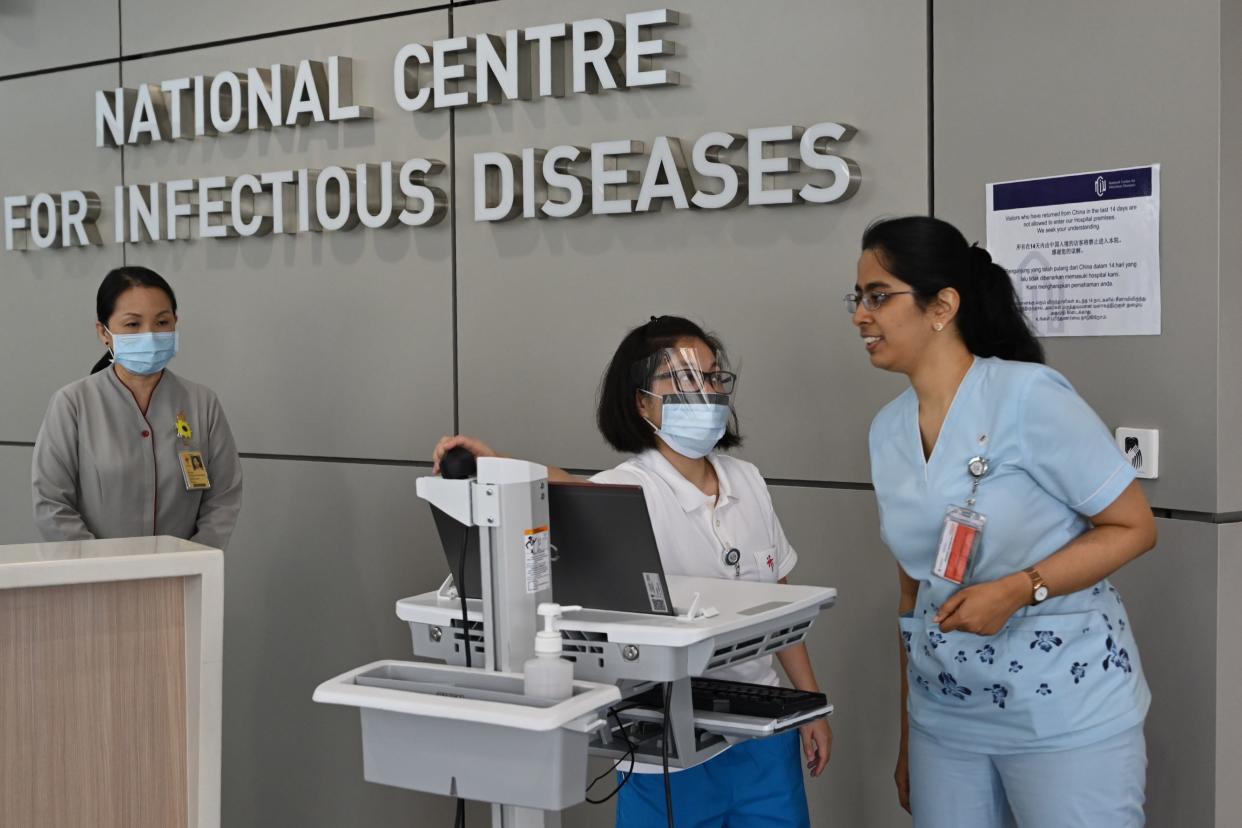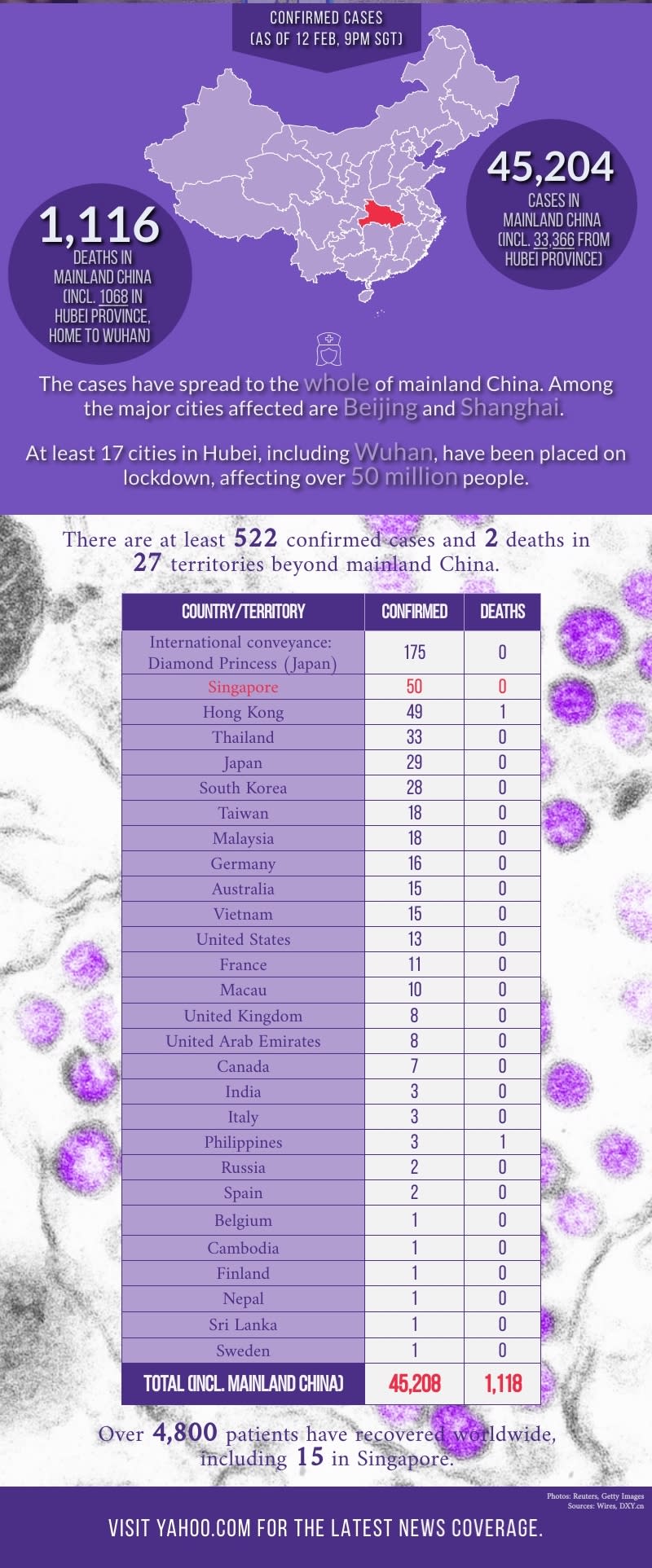COVID-19: Six-month-old infant 'doing well', too early to predict peak of virus here, says senior MOH official

By Wong Casandra and Amir Hussain
SINGAPORE — The youngest confirmed case of the coronavirus here, a six-month-old Singaporean male infant, is doing well but is not among the six newly discharged cases on Wednesday (12 February), said a senior Ministry of Health (MOH) official.
During a press conference led by the multi-ministry taskforce on the COVID-19 virus, Associate Professor Kenneth Mak, the ministry’s director of medical services, said the six cases who have fully recovered and discharged on Wednesday are adults.
Among them are two Chinese nationals from Wuhan – a 36-year-old man and a 37-year-old woman – and four Singaporeans.
The locals are a 41-year-old man with no links to previous cases as well as the 40-year-old husband of a tour guide who brought Chinese tourists to health products shop Yong Thai Hang and the shop’s two workers, a 40-year-old woman and a 36-year-old man.
This brings the number of fully-recovered patients in Singapore to 15 out of a total of 50 confirmed cases. Of the total, three new cases were announced at the conference on Wednesday – two Grace Assembly of God church workers and a DBS employee at Marina Bay Financial Centre.
Most of the remaining 35 hospitalised cases are stable or improving, said Prof Mak.
Eight remain in critical condition in the intensive care unit, with no “clear pattern” among the critically ill, he added.
Taskforce co-chair and Health Minister Gan Kim Yong said, “While most infected patients will recover, some may become seriously ill and a small number may succumb to the infection ultimately. We have to be prepared for the worst.”
‘Too early’ to predict exact peak of epidemic
When asked about a media report on the virus epidemic peaking in China later this month and ending around April, Prof Mak said that while authorities are aware of it, he considered it “difficult” to be confident in the timeline, given that cases are still being diagnosed.
Zhong Nanshan, an 83-year-old epidemiologist who won fame for combating the 2003 Severe Acute Respiratory Syndrome (SARS) epidemic, told Reuters on Tuesday that the outbreak will peak in middle or late February in China, followed by a plateau and decrease.
"I hope this outbreak or this event may be over in something like April,” Prof Zhong had said.
Prof Mak noted, “In general, if we see a peak at a certain time in China, given the pattern (of spread globally)...that peak in other countries may occur one to two months later.”
Calling it “too early” for local authorities to accurately predict the outbreak’s pattern here, Prof Mak stressed that more data is required to do so.
“You need to see, for example, more cases in the country, to understand exactly an outbreak that occurs in the country itself,” he added.
Of the 50 cases here, 28 are local transmissions, more than half of the tally. Eight have no established links to previous ones or travel history to mainland China.
As of Wednesday noon, 638 of the suspect cases have tested negative for the virus while results for the remaining 125 are pending.
The MOH has also identified 1,090 close contacts as of noon. Of the 984 who are still in Singapore, 961 are quarantined or isolated while efforts are underway to contact the remaining 23 close contacts.
Given the heightened risk, authorities last Friday raised Singapore’s Disease Outbreak Response System Condition (Dorscon) alert level from yellow to orange amid the increase in confirmed cases of the coronavirus.

Grand Hyatt cluster: Servomex’s response
Speaking on the sidelines of the conference, Prof Mak said the Singapore authorities do not have information from all business meeting participants at the Grand Hyatt hotel here, one of five identified clusters in Singapore, and they continue to be in contact with their relevant counterparts in other countries to get more information.
“We would perhaps not be completely clear about who that first patient might be...It's less important for us to find out who patient zero is at this point in time. More important for us is to track the outcome in the health status for all participants as far as we can,” he added.
The internal meeting, held at the Grand Hyatt from 20 to 22 January, was attended by 109 staff from UK firm Servomex.
Ninety-four foreign participants, including a Chinese delegate from Wuhan where the virus originated, have since left Singapore.
At least seven attendees have tested positive for COVID-19, including three Singaporeans as well as one British, one Malaysian, and two South Korean nationals. The sister and mother-in-law of the Malaysian attendee were confirmed to be infected, while the British participant infected 11 others.
In response to queries from Yahoo News Singapore, a Servomex spokesperson said that throughout the situation, the company has acted on advice from the health authorities in the UK and Asia.
Its first employee was diagnosed on 3 February and by this time, the company had “implemented extensive measures to contain the virus and protect our employees and the wider community”, according to the spokesperson.
None of the company’s employees from China have tested positive for the virus, the spokesperson added.
The other four clusters are associated with health products shop Yong Thai Hang along Cavan Road, The Life Church, and Missions Singapore in Paya Lebar, a worksite along Seletar Aerospace Heights as well as Grace Assembly of God church.
Death toll surpasses SARS epidemic
The novel strain belongs to the same family of coronaviruses as SARS, which killed nearly 800 people globally during a 2002-2003 outbreak and also started in China.
It likely originated from Wuhan’s Huanan Seafood Market, where live animals or products – such as foxes, wolf puppies, giant salamanders, snakes, porcupines, and camel meat – are sold.
Declared a global emergency by the World Health Organisation (WHO), COVID-19 has spread to 27 territories beyond mainland China, sickening over 45,000 people worldwide.
The WHO also said that cases being transmitted by people who have never travelled to China could be the "tip of the iceberg".
By territory, Singapore has the second-highest number of confirmed COVID-19 cases after mainland China. The global tally includes cruise ship Diamond Princess, moored off Japan, which has 175 cases.
Five Singaporeans on board the ship have reported that they are physically well, said a Ministry of Foreign Affairs spokesperson on Wednesday, in response to Yahoo News Singapore’s queries.
China's death toll from the epidemic at 1,113 has surpassed the total fatalities globally from the SARS outbreak. On Saturday, the US embassy confirmed that a US citizen died that day in Wuhan.
Two territories, Hong Kong and the Philippines, have each reported the death of a patient from the virus.
Patients suffering from the new strain may exhibit fever and symptoms of lower respiratory illness – such as coughing or difficulty in breathing – as well as pneumonia-like symptoms like a runny nose, sore throat, and headache.
However, some who have died from it have not displayed symptoms of fever, according to details released by China’s National Health Commission, potentially complicating global efforts to check for infected travellers as they arrive at airports and other travel hubs.
Chinese authorities, meanwhile, dismissed two senior health officials from Hubei province where some 56 million people, including in its capital Wuhan, have been under lockdown since late last month.
They also tightened restrictions in the city, forbidding people with fever from visiting hospitals outside of their home districts and sealing off residential compounds.

Stay in the know on-the-go: Join Yahoo Singapore's Telegram channel at http://t.me/YahooSingapore
Related stories:
COVID-19: Singapore confirms 3 new cases, 2 went to same church
Coronavirus: How it's spreading in Singapore and the world
COVID-19: GrabCare launched to ferry healthcare personnel to and from hospitals
Coronavirus: SAF to stagger meal times, step up disinfections
Coronavirus: Singapore and Malaysia to set up joint working group to control spread


